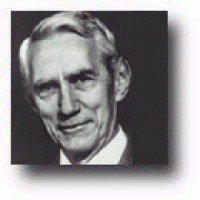
RIP Claude Shannon
What do the following all have in common: digital communications, juggling machines, mechanical maze-solving mice and motorized pogo sticks? The answer is that they were all invented by the mathematician Claude Shannon.
Shannon was one of the most important mathematicians of the 20th century, whose work in the 1940s became the foundation for the technology that enables you to view this web page via your telephone line. He was the first person to realise that any sort of message, including this web page, could be transmitted as a series of 0's and 1's, regardless of whether it was words, numbers, pictures or sound.
In his Master's thesis, Shannon showed that these binary digits (the 0's and 1's) can be represented by electrical switches. The digit 1 was represented by a switch that was turned on, and 0 by a switch that was turned off. Moreover, he used Boolean algebra to show that complex operations could be performed automatically on these electrical circuits, thus manipulating the data they were storing. Today we use his mathematics all the time, as digital circuits are the basis of modern computers and telecommunications systems. It was in one of his papers, "A Mathematical Theory of Communication" published in 1948, that the word "bit" (short for binary digit) was used for the first time. In fact the framework and terminology for information theory he developed remains standard today.
![[IMAGE: Claude Shannon]](/issue15/features/shannon/shannon.jpg)
Claude Shannon and his electromechanical mouse Theseus, one of the earliest experiments in artificial intelligence. (Image Copyright 2001 Lucent Technologies, Inc. All rights reserved.)
Shannon was driven by curiosity, and in his own words he "just wondered how things were put together". He invented many things including a juggling machine, rocket-powered Frisbees, motorised Pogo sticks and a device that could solve the Rubik's Cube puzzle. He was involved in pioneering artificial intelligence research, trying to teach machines to learn. This included building the electromechanical mouse called "Theseus" that could navigate a metal maze using magnetic signals. Shannon also built a chess-playing computer many years before IBM's Deep Blue, that played very well against the world champion of the time, Mikhail Botvinnik (the computer lost only after 42 moves).
As a mathematician whose work pioneered digital communication and artificial intelligence and was influential in cryptography, probability, investment theory and even biology and psychology he was one of the most important people of the 20th century, and as someone who could ride a unicycle while juggling three balls he must have been a remarkable person indeed.
Claude Shannon died on February 24 2001 at the age of 84. He was survived by his wife Mary (a numerical analyst) and a son, daughter and two granddaughters.
An entry in the Digital Century's online encyclopediaMIT obituary
Bell Labs Obituary
About the author

Rachel Thomas is a computer officer with the Millennium Mathematics Project. Rachel obtained her MSc in Semigroup Theory in 1998 from the University of Western Australia. Since then she has worked in a variety of jobs applying mathematics to problems in the real world, such as data management and learning flamenco.
Comments
Anonymous
A few years ago i saw a documentation about Claude Shannon. As a electrical hobbiest that i am i were totaly stunned by the electronic devices he invented during that times. Espetially not only because of that it where real possible to create for example a remote controled toy car during that times, also because of his humor that he put into the construction of some of his inventions. I remembered him a few weeks ago and started to search the web for him and his devices. And hey! Some of it became popular :) It seems that his ultimate machines are now part of the pop or web culture.